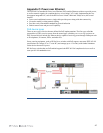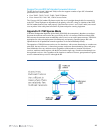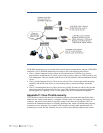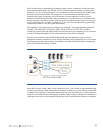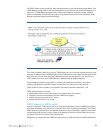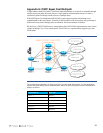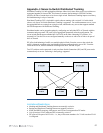
50
In order to receive a multicast stream, routers explicitly join the stream by sending join messages to the
RP. This join message is analogous to a unicast router following a default route to a destination.
Effectively, the function of the RP is a place for multicast sources and receivers to meet.
PIM-SM is extremely memory and CPU efficient. Since the only thing that most routers need to know
is how to reach the RP, memory requirements are greatly reduced. There are several methods that can
be used by routers in a PIM-SM domain to learn where to find the RP. Probably the simplest
mechanism is statically configuring all routers to reach the RP. However, if the routers are statically
configured to an RP and the RP fails, then the multicast network is no longer functional.
Alternatively, the RP can be learned dynamically through the PIM-SM bootstrap mechanism. Since
this bootstrap mechanism is dynamic, it allows for network changes and redundancy. The PIM-SM
bootstrap mechanism is generally the recommended approach for simplicity and redundancy.
Appendix E: LLDP-MED
IEEE 802.1AB Link Layer Discovery Protocol (LLDP) provides a standards-based method that
enables devices such as HP ProCurve switches to advertise themselves to adjacent devices and to learn
about adjacent LLDP devices. An LLDP packet transmitted by a HP ProCurve switch contains data
about the switch and port. The switch advertises itself to adjacent (neighbor) devices by transmitting
LLDP data packets out all ports on which outbound LLDP is enabled, and reading LLDP
advertisements from neighbor devices on ports that are inbound LLDP-enabled. An LLDP-enabled
port receiving LLDP packets inbound from neighbor devices stores the packet data in a neighbor
database (MIB).
LLDP provides the base capabilities for network devices, but was not considered sufficient for IP
telephony devices. As a result, in 2004, an initiative by Mitel, HP ProCurve, Avaya, and Enterasys was
undertaken to enhance LLDP so that it could better support IP telephony devices. The development of
LLDP-Medium Endpoint Discovery (LLDP-MED) (ANSI/TIA-1057/D6) extended the LLDP standard
to support advanced features on the network edge for VoIP endpoint devices with specialized
capabilities and LLDP-MED standards-based functionality. The extensions to LLDP include the
specification of additional TLV (type, length, and value) entries specifically for VoIP management.
LLDP-MED benefits include:
• Plug-and-play provisioning for MED-capable, VoIP endpoint devices
• Simplified, vendor-independent management enabling different IP telephony systems to
interoperate on one network
• Automatic deployment of convergence network policies that include voice VLANs, Layer 2/CoS
priority, and Layer 3/QoS priority
• Configurable endpoint location data to support the Emergency Call Service (ECS) such as
Enhanced 911, 999, and 112
• Detailed VoIP endpoint data inventory readable via SNMP from the switch
• Power over Ethernet (PoE) status and troubleshooting support via SNMP
• Support for IP telephony network troubleshooting of call quality issues via SNMP








